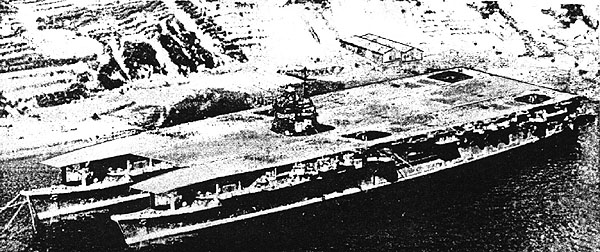



| Displacement | 25,000 tons |
| Armament |
Numerous medium and light AA |
| Speed | 31 knots |
| Aircraft | 72 + deck park |
| VTS Rating | 0 3 6 |
Japanese naval designers had been impressed with reports of an Allied CV capable of launching and recovering aircraft simultaneously (USS Bon Homme Richard). The Allies built extra deck space canted outward, but this was unacceptable to the Japanese because it would limit mounting AA guns. More than one Japanese airman had seen Hiryu and Soryu cruising together with their left and right islands close, and wondered how they might look joined.
An astonishing idea emerged. What would happen if two hulls were joined, like a catamaran, and the space between decked over?!! For structural rigidity the flight deck would not be the strength deck, as was common with other Japanese CV's. Rather, the lower hangar deck became the strength deck, supported by arched girders between the hulls. In this arrangement, the hangar and flight decks became superstructure, as in American carriers.
The catamaran CV would provide increased room for pilot error on approach (an important benefit as the quality of Japanese pilots deteriorated), and an enormous handling area or deck park. The island, centered over the joining section, would contain a single captain's bridge and combat information center, but would have separate flight operations centers for each side. Aircraft could be readied in either hull's hangar, then trundled across the upper hangar deck to whichever side needed them. Besides launching on one side and recovering on the other, a single massive strike including the deck park could be flown off in short order. Stack gasses were trunked down between the hulls.
In adjacent slipways, two high-speed oilers under construction lay idle due to the Fleet Replenishment Program's emphasis on CVs. The construction workers enthusiasticallly embraced the catamaran conversion idea, so completion came quickly. Because of the long distances aircraft had to be moved, motor tractors (commonplace on American CVs) were featured for the first time aboard Japanese CVs. After launching, the design speed of 28 knots was surpassed by three knots due to the benefits of the catamaran configuration. The double hull prevented most rolling and yawing, making her a more stable flying and gun platform. Because of the two hulls, the Nibai (Japanese for 'double') was considered a carrier division herself and required a rear admiral assignment.
During the Marianas sea battle, the Nibai provided continuous air cover for the fleet, harassing Mitscher's planes at long range so they ran out of fuel returning home. A U.S. submarine reported "two carriers refueling" and fired torpedoes that hit both hulls. Down by the bows and limping back to Kure Navy Yard, she was repaired enough to accompany Ibuki on a final special mission. Loaded up with "Jinpu-Kai" fighters, Nibai and Ibuki launched them far out at sea to successfully escort Renzan bombers carrying the new "Doshaburi" Kamikaze rocket plane. Two large British carriers were disabled by the attack, but upon her return to Kure, Nibai was sunk at her moorings by U.S. carrier aircraft.


